Three Days of Battle
17, 18, 19 October, 2008
Groenlo, The Netherlands
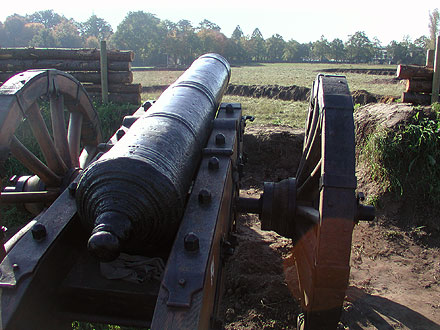 |
| The 24-pound cannon overlooking the battlefield
where some trenches may be seen. This
and other battlefield photographs were taken the day following
the third battle. Being in the battles I had no
opportunity to take pictures then. |
The battle was to simulate a siege, with a battlefield unlike any
I’ve experienced before. At one end, a low bastion was of built-up earth
with
storm poles set into the sides and on this artillery was mounted.
Zigzagging in front of that across more than half of the battlefield
were trenches, like
in one of the illustrations on this Web page, with the removed
earth heaped on the trench side facing the enemy (so as a trench went
from zig to zag, the removed dirt was placed on one side, then the
other). The trenching was done with an excavator beforehand, so any
shovel work by re-enactors was simply for show. The trenches themselves
were only about two-thirds of a meter deep, but what was dug out piled
on one side of the digging, to give enough protection to allow us to
stand erect in a trench.
At Sealed Knot events I’d attended in the U.K., there was artillery,
often plenty of it for a grand show. Due, however, to the economics of
manufacture, transport, storage, and gunpowder costs, plus moving onto
and off the fields, nearly all S.K. cannon are of small bore, such as
three-pounders, sakers, falcons, etc. At Slag om Grolle, though, among
the cannon atop the bastion was a real, firing 24-pounder, the caliber
of cannon often used in siege warfare back then. And when it fired, its
sound, smoke and concussion were not to be forgotten, especially when
one was in front of it.
Hopton’s Tercio was on the Dutch side all three days, so my preparation
for shouting “¡Santiago!” and “¡Viva España!” had to be adjusted to
“¡Muerta a España!” The only other Sealed Knot unit was the
Parliamentarian Manchester’s which was placed with the Army of Flanders.
The Bavarians with whom I breakfasted went to that side, too (although
during the third battle they ‘deserted’ to the Dutch side).
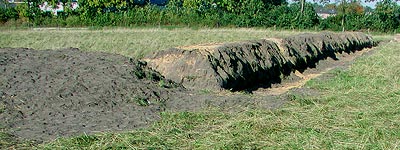 |
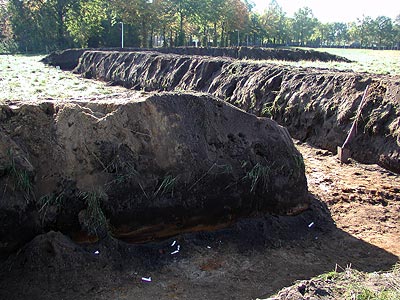
The zig-zag nature of trenches. With the removed dirt piled up
on the enemy side, standing safely was possible. |
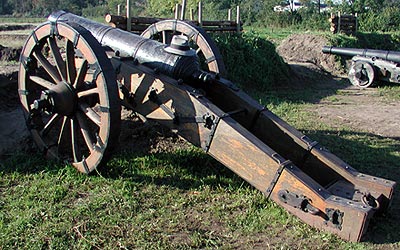
To provide scale for the 24-pounder, atop the touch hole at the breech is my
fedora, its total length 12 inches. |
We on the Dutch side had the trenches and the 24-pounder. As aspect of
the arrangement was to extend the trenches day by day toward the Army of
Flanders side, and the actual digging was done between battles by the
excavator. To begin the battles on the second and third days, a scenario
called for an engineer to be out in front of the trenching, protected by
pike and musketeers, then set upon by enemy cavalry. The cavalry would
create some casualties and chase the engineer and surviving Dutch troops
from their spot. On the second day, I was among the protecting party and
on cue acted fierce, then scampered back to the trenches.
The cavalry consisted of six Czech horsemen and their mounts. Their kit
was the armor of cuirassiers. The riders were very skilled and the
horses were the best trained those in Hopton’s had seen, comparing to
the Sealed Knot. The warning was that if the pike formation did not
maintain an even, unwavering front, one, then the rest, of the horse
would exploit the smallest of gaps. Keeping that in mind, we pike were
quick to respond to any threat and make walls with our ‘Charge for
Horse.’ They never broke into us, but not for want of trying.
All three battles were grand shows and complex, with thrust and counter
thrust. Being a participant, I could focus only on the situation and
people immediately around me, follow orders, and
wait-charge-stand-withdraw-wait... So, my experience was constricted
which reflects upon my reportage.
On the first battle east Germans in the role of a Scots
regiment fought so enthusiastically they broke nearly half their pikes. Near the
crowd line, Hopton’s skirmished against one, then another enemy unit,
with the French coming into our trench and wanting to go at us in the
S.K.-style push of pike. We obliged and, since they were more
enthusiastic than experienced, we trounced them.
Two actions for the second and third battles suffered communication issues.
On the second day, the Army of Flanders was to prevail. The Dutch side
was to make a final grand charge to be met by the enemy boiling out of
their defenses, which was to inflict numerous casualties, forcing the
Dutch to retreat pell-mell. The cue for the grand charge was, as our
side was told, two volleys of cannon fire. The other side got that as
three volleys of cannon fire. So, we charged – and they stood there.
Ordered not to go down into the enemy, we on the Dutch side gestured
like we were being repelled and took many casualties before falling back
in a flaccid retreat.
For the opening of the third battle, we Hopton’s pike left our pikes
back at the bastion and pretended to be digging one of the trenches,
making a nice little show of throwing out dirt. The scenario was that
the enemy cavalry, after chasing away the engineer and his guard, was to
regroup, then charge those digging the trenches, and we were to scurry
like rabbits back through the trenches to retrieve our pikes. We were in
one trench line and on the far side of the field was the second trench
line, a mirror image of ours. The Czechs had consulted beforehand with
our Colonel but Czech <> English – something was lost. The engineer and
his men were dispersed, the cavalry regrouped – then charged the other
trench line where they did not chase after unarmed diggers but battled
feisty musketeers. We could only watch. Finally, our pike officer asked
the Colonel if we could go back to fetch our pikes, which we did in a
most undramatic way. Overall, the three days of battle went well, with
plenty to see and do. If one group of troops was waiting or
marching on the field, there were other groups going at each other.
Planning and leadership paid off. The audience saw non-stop
action, and each re-enactor was served generous portions of fighting.
 Near
the end of the second day's battle, I saw a couple of puffs of
pale smoke erupt from the hip area of a soldier jumping up several meters
behind us. He struggled to pull off his breeches, exposing his
thighs. More smoke and he went down. Several rushed
to his aid, one of whom was the wife of Hopton's colonel who
knew some Sealed Knot first aid. She took control of the
situation. She reported that on the upper thighs, close by
the - ahem - family jewels, she saw fabric melted into the burns
which looked "like cooked bacon"; the fabric was a
wool/polyester blend. As she administered first aid at the
place of the injury, someone asked: "Are you going to kiss it to
make it well?" Even the burn victim laughed. Then he
fainted. An ambulance came for him as all of us left the
field. The next day, the man was seen walking about. The
incident was due to the man carrying packets of gunpowder (paper
cartridges?) in his pocket and then falling upon some lit match. Near
the end of the second day's battle, I saw a couple of puffs of
pale smoke erupt from the hip area of a soldier jumping up several meters
behind us. He struggled to pull off his breeches, exposing his
thighs. More smoke and he went down. Several rushed
to his aid, one of whom was the wife of Hopton's colonel who
knew some Sealed Knot first aid. She took control of the
situation. She reported that on the upper thighs, close by
the - ahem - family jewels, she saw fabric melted into the burns
which looked "like cooked bacon"; the fabric was a
wool/polyester blend. As she administered first aid at the
place of the injury, someone asked: "Are you going to kiss it to
make it well?" Even the burn victim laughed. Then he
fainted. An ambulance came for him as all of us left the
field. The next day, the man was seen walking about. The
incident was due to the man carrying packets of gunpowder (paper
cartridges?) in his pocket and then falling upon some lit match. |
The final battle swayed back and forth. As the Army of Flanders pushed
back the Dutch, Hopton’s was ordered to fall back to the trench in front
of the cannon-topped bastion. Soon after we dropped into the trench, I
heard the cry that the 24-pounder was about to fire – only meters
directly behind us. Officers yelled at us to get down behind the trench
sides to protect us from the forthcoming concussion. I hunkered down. I
saw the puff of smoke from the touch hole with its flash, then the great
roll of white smoke from the muzzle – but being protected by the trench,
only lightly felt the concussive blast sweep above us.
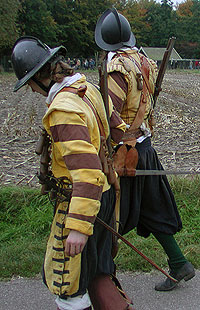 Then the word came to advance. We scrambled out of the trench. I dropped
onto my hands and knees to provide my back as a step for a musketeer who
was having difficulty. Then an officer hoisted me up by my arm and away
we went at the Army of Flanders – but not before my snapsack opened to
spill everything out, which I rammed back in and rejoined the charge. Then the word came to advance. We scrambled out of the trench. I dropped
onto my hands and knees to provide my back as a step for a musketeer who
was having difficulty. Then an officer hoisted me up by my arm and away
we went at the Army of Flanders – but not before my snapsack opened to
spill everything out, which I rammed back in and rejoined the charge.
The battle concluded with the Dutch pouring down into the defenses of
the Army of Flanders with a great pretend slaughter ensuing.
The moment in all three days that stands out in my memory happened
during that confused assault on the second day. Several commented during
and after the battle that the weather conditions were not usual. The sky
was overcast whilst the air very still. Cannon and musket smoke did not
drift away but instead tended to sink to the ground. The Army of
Flanders made that second cannon volley and Hopton’s was among the
vanguard of the charge; I was running not far behind the Colonel. The
memory is seeing only him running in front of me, no one else, his sword
raised high and the pale cannon smoke closing around, enveloping him
from sight. Such a moment!
See what others have recorded of
this Slag om Grolle (with video) |
Back to main menu
for Reliving History |


 Then the word came to advance. We scrambled out of the trench. I dropped
onto my hands and knees to provide my back as a step for a musketeer who
was having difficulty. Then an officer hoisted me up by my arm and away
we went at the Army of Flanders – but not before my snapsack opened to
spill everything out, which I rammed back in and rejoined the charge.
Then the word came to advance. We scrambled out of the trench. I dropped
onto my hands and knees to provide my back as a step for a musketeer who
was having difficulty. Then an officer hoisted me up by my arm and away
we went at the Army of Flanders – but not before my snapsack opened to
spill everything out, which I rammed back in and rejoined the charge.